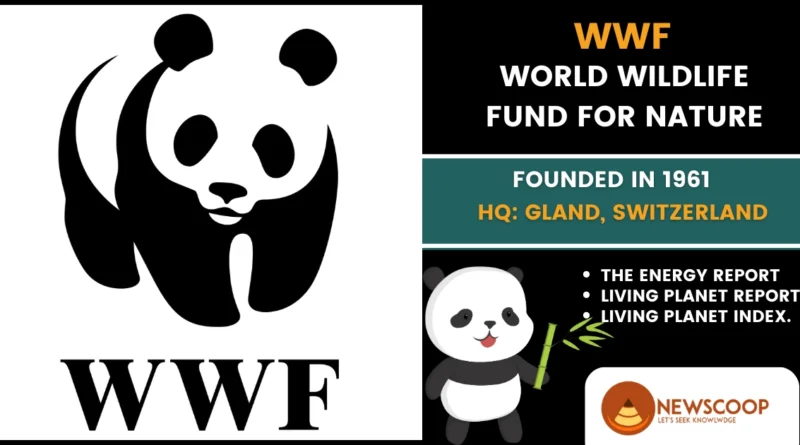World Wildlife Fund for Nature (WWF)
Environmental conservation is a pressing global issue, and organizations like the World Wildlife Fund (WWF) play a crucial role in addressing it. With their dedicated efforts, WWF has become a leading force in the conservation of biodiversity, sustainable development, and the mitigation of climate change.
This article explores the history, objectives, achievements, partnerships, challenges, and relevance of WWF for UPSC (Union Public Service Commission) aspirants.
What is World Wildlife Fund for Nature (WWF)?
The World Wildlife Fund for Nature (WWF) is an international non-governmental organization (NGO) that focuses on the conservation of nature and the promotion of sustainable development. Moreover, WWF works to protect endangered species, preserve critical habitats, advocate for environmental policies, and engage with communities and governments to address environmental challenges globally.
| Aspect | Details |
|---|---|
| Year of Formation | 1961 |
| Founders | Sir Julian Huxley, Prince Bernhard of the Netherlands, and others |
| Original Name | World Wildlife Fund |
| Current Name | World Wide Fund for Nature (WWF) |
| Headquarters | Gland, Switzerland |
| Mission | Conservation of nature and promotion of sustainable development |
| Global Presence | Active in over 100 countries |
| Key Focus Areas | Biodiversity conservation, climate change, freshwater, wildlife, forests, oceans |

Objectives of World Wildlife Fund (WWF)
The objectives of the World Wildlife Fund for Nature (WWF) are as follows:
- Biodiversity conservation and protection of endangered species.
- Promotion of sustainable development practices.
- Mitigation of climate change and reduction of greenhouse gas emissions.
- Preservation of critical habitats and restoration of ecosystems.
- Advocacy for stronger environmental policies and regulations.
- Collaboration with governments, businesses, and local communities.
- Engagement in scientific research and data-driven conservation initiatives.
- Education and awareness-raising on environmental issues.
Headquarters of WWF
The headquarters of the World Wildlife Fund for Nature (WWF) is located in Gland, Switzerland.
What is the Logo of WWF?
The logo of the World Wildlife Fund for Nature (WWF) features a black and white image of a giant panda. The panda is depicted in a distinctive, stylized manner, with black patches around its eyes, ears, and limbs against a white background.
The panda symbolizes WWF’s commitment to wildlife conservation and raising awareness about endangered species. The logo is widely recognized and has become synonymous with the organization’s efforts to protect nature and promote sustainable living.
Work Areas
Currently, the work of the World Wildlife Fund for Nature (WWF) is organized around six key areas:
- Food
- Climate
- Freshwater
- Wildlife
- Forests
- Oceans
Publications of WWF
- The Energy Report
- Living Planet Report
- Living Planet Index.
Major Programs of WWF
WWF has implemented various programs and initiatives to address environmental challenges and promote conservation. Some prominent programs include:
- Earth Hour: A global grassroots movement that encourages individuals, communities, and businesses to switch off non-essential lights for one hour to raise awareness about climate change.
- Living Planet Campaigns: WWF runs campaigns to advocate for the conservation and protection of specific habitats, species, or ecosystems, aiming to mobilize public support and drive positive change.
- Forest and Wildlife Protection Programmes: These programs focus on combating illegal logging, poaching, and wildlife trafficking, while also promoting sustainable management and conservation of forests and wildlife.
- Sustainable Fisheries Initiatives: WWF works with fisheries and seafood industries to promote sustainable fishing practices, reduce overfishing, and protect marine biodiversity.
Background & Formation of World Wildlife Fund (WWF)
In the mid-20th century, growing concerns about environmental degradation and the loss of biodiversity sparked a global conservation movement. Visionaries recognized the need for a coordinated effort to address these pressing issues and protect the planet’s natural resources.
Formation: In 1961, the World Wildlife Fund for Nature (WWF) was established as an international organization dedicated to nature conservation. The founding members included influential figures from the scientific and conservation communities, such as biologist Sir Julian Huxley and naturalist Sir Peter Scott. The organization’s initial focus was on protecting endangered species and preserving critical habitats.
Panda Logo: One of WWF’s iconic symbols is the giant panda, which became the organization’s logo in 1961. The choice of the panda reflected the need to raise awareness about endangered species and the importance of their conservation. The panda’s gentle nature and charismatic appeal made it a powerful symbol to garner public support for WWF’s conservation efforts.
Name Change to World Wide Fund for Nature: In 1986, the organization changed its name from World Wildlife Fund to World Wide Fund for Nature to reflect a broader focus beyond wildlife conservation. The new name emphasized the organization’s commitment to conserving the entire spectrum of nature, including ecosystems, habitats, and biodiversity.
Collaboration with the International Union for the Conservation of Nature (IUCN): WWF has maintained a close partnership with the International Union for the Conservation of Nature (IUCN) since its inception. The IUCN provides scientific expertise and guidance to WWF, strengthening its conservation strategies and initiatives.
Also Read: BIMSTEC
WWF India
WWF India is a prominent organization established as a Charitable public trust on 27 November 1969. It was formed with the primary objective of protecting and safeguarding India’s natural heritage and ecology. The organization’s secretariat is located in New Delhi.
Mission Statement: The mission of WWF India is to conserve the world’s biological diversity, ensure the sustainable use of renewable natural resources, and promote the reduction of pollution and wasteful consumption.
Priority Species:
- Tiger
- Elephant
- Rhinos
- Red panda
- Snow leopard
- Nilgiri tahr
Priority Landscapes:
- North Bank Landscape
- Kaziranga Karbi Anglong Landscape
- Terai Arc Landscape
- Sunderbans
- Western Arunachal
Education Programs:
- WWF India runs five education programs across 16 states in India, focusing on increasing awareness related to the environment.
- Nature Clubs of India is involved in facilitating these awareness programs.
WWF India’s tireless efforts contribute significantly to India’s conservation landscape, playing a crucial role in protecting its diverse ecosystems and promoting sustainable development. By focusing on priority species, landscapes, and educational programs, WWF India strives to create a harmonious balance between human development and the preservation of nature.
Conclusion
The World Wildlife Fund for Nature (WWF) has established itself as a prominent global organization dedicated to conserving nature and promoting sustainable development. Through its history, objectives, achievements, partnerships, and educational initiatives, WWF has made substantial contributions to environmental conservation.
UPSC aspirants can benefit from engaging with WWF’s work, drawing on its valuable resources and examples to enhance their understanding of environmental issues. As we strive for a sustainable future, WWF’s efforts continue to be instrumental in preserving our planet’s precious biodiversity.
Thank You!

